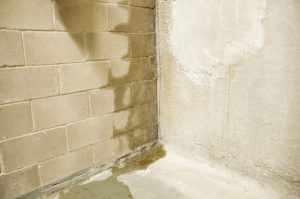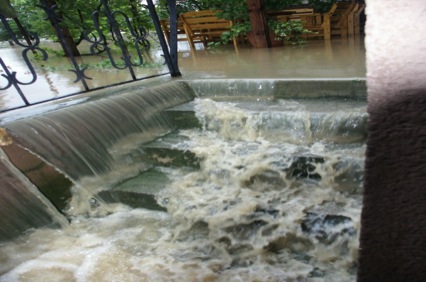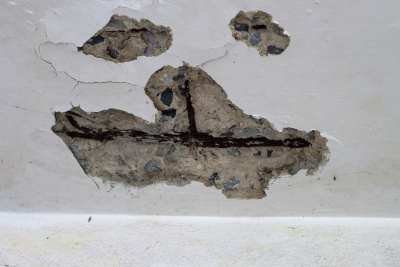Sneaky Signs of a Wet Basement
 Sometimes, when a basement is wet, it’s obvious. Especially if there’s been a flood, standing water in the basement is a clear sign that you’ve got a wet basement problem. What’s more dangerous is the signs of a wet basement that are more insidious. Paying attention to your basement and regularly checking for the sneakier signs of a wet basement can give you the opportunity to address any issues before they become serious problems. Do you know what to look for?
Sometimes, when a basement is wet, it’s obvious. Especially if there’s been a flood, standing water in the basement is a clear sign that you’ve got a wet basement problem. What’s more dangerous is the signs of a wet basement that are more insidious. Paying attention to your basement and regularly checking for the sneakier signs of a wet basement can give you the opportunity to address any issues before they become serious problems. Do you know what to look for?
- Water stains should clue you in to the fact that you have a leaky basement. You might see stains along the floor or on the walls, or you might notice blistering paint. Sometimes, you might see a ring of dampness at the base of concrete walls, or condensation on the walls and floor, or even water trickling out of the walls. These are all signs that your basement is wet, but the causes of this dampness can vary.
- A musty smell can alert you to excess moisture. If your basement smells unpleasant, especially if the air feels damp and humid, it could be a sign that it’s collecting water. This can be a big problem if it spreads to things you have stored in the basement, or into the rest of your home.
- Mold and mildew are two unfortunate consequences of a damp basement. They can be yellow, green, black, or brown, but whatever color they are, they spell trouble. If you notice mold or mildew in your basement, it’s smart to get it tested by a mold specialist, so that you can determine whether you need mold eradication as well as basement waterproofing.
- Efflorescence happens when water evaporates from the walls and leaves behind salt deposits. These deposits look like a white or grayish ash on the walls, sometimes with a bit of a sparkle. Even though the water has evaporated, seeing those deposits on the wall should alert you that it has found a way into your basement.
- Concrete spalling means that the face of a concrete, brick, or stone wall is flaking, peeling, or popping off. It happens when water gets inside the surface of these materials and leaves salt deposits. If there’s concrete spalling, there is an entrance in your basement for seepage.
- Rot is a bad sign. It might manifest as deteriorating carpet or wood, or it might be rotting columns, headers, and joists, but it always means the water in your basement is causing problems.
Perhaps more important than knowing the signs of a wet basement is knowing how to determine where the water is coming from. Water in the basement usually comes from one of three sources. It could be rain or groundwater that’s made its way inside, often caused by improper grading or faulty downspouts or gutters. Alternately, it could be an interior water source. Dryers, showers, cooking, humidifiers, and newly constructed concrete can all be sources of moisture in your basement. Sometimes, ventilation is the problem, and in trying to ventilate our basements by opening the windows we let in outside air that condenses on the walls and floors. So once you’ve identified the source of the water, how do you fix it?
- An interior water leak is perhaps the easiest basement moisture cause to rectify. Determine the source of the leak, whether it’s a shower, sink, toilet, washing machine, dishwasher, bad pipe, or some other water source. Once you’ve found the leak, you can fix it or hire someone to fix it. Repairing the leak may eliminate the problem entirely.
- Often, rain or groundwater gets into your basement because of poor grading. If the ground around your foundation slopes toward the foundation instead of away from it, water will pool around your foundation and then make its way inside. To fix this problem, you’ll need to build up the dirt around your foundation by at least one inch per foot for a minimum of six feet, sloping away from the house.
- Gutters and downspouts that aren’t functioning properly can direct water into your basement. Water that drains toward your house because the gutters and downspouts are missing or defective will pool in the soil around the foundation. Once it’s around the foundation, it’s easy for it to get into your basement. Obviously, the way to fix this problem is to fix your gutters. If you don’t have gutters, install them, taking care to place at least one downspout for every 50 feet of roof eave. Then install extenders on the downspouts, to make sure the water is carried at least four feet away from the foundation.
- Cracks in your foundation can mean water in your basement. Here’s an interesting fact: sometimes the water actually causes the cracks, then moves into the basement using those same cracks. This can happen if the floor joists are not properly connected to the foundation walls, or if there’s poor drainage in the soil. Solutions to this problem depend on the exact situation. The important thing is to repair the cause of the cracks and then repair the cracks themselves.
- A house without an adequate under-the-floor drainage system can result in a damp basement. Older homes, built before basements tended to be inhabited spaces, don’t typically have under-the-floor drainage at all. Newer homes that do have drainage systems often have problems with them. Drains clog, connections break, and sump pumps malfunction. It’s hard to fix these problems, and really, the necessary repairs are best left to the professionals.
- Condensation is a much simpler problem than poor drainage or a leak. It happens when warm, moist air meets cool basement walls and floors and creates moisture. You can fix this problem by first determining why it happened, and making sure it won’t happen again, then using an exhaust fan or finding a way to increase the air circulation in the basement. It’s also a good idea to insulate the places where condensation occurs, to keep the walls from being significantly cooler than the air.
- The best defense is a good offense. If you don’t yet have trouble with a wet basement, don’t allow trouble to start. Instead, waterproof your basement to ensure that it stays dry no matter what happens. In addition to protecting your basement from water, waterproofing prevents mold growth and protects your home’s structural integrity.
If you really want to take charge of your basement and make sure it’s properly maintained, it may be time to call in a professional. At Budget Waterproofing, we’ve got more than 55 years of experience servicing both commercial and residential customers throughout Maryland. We’re proud of our craftsmanship and confident in our skills, and all of our technicians are fully licensed, insured, and bonded. Whether your problem is moisture, humidity, or mold in your basement, we have the experience and know-how to provide the solution. For more information, call 410.690.4970 or contact us through our website.


